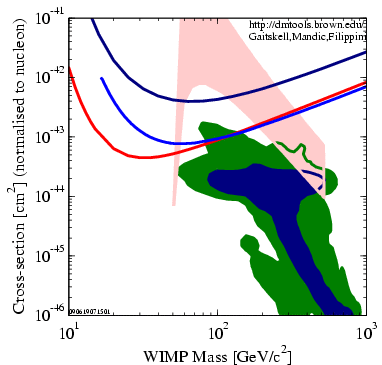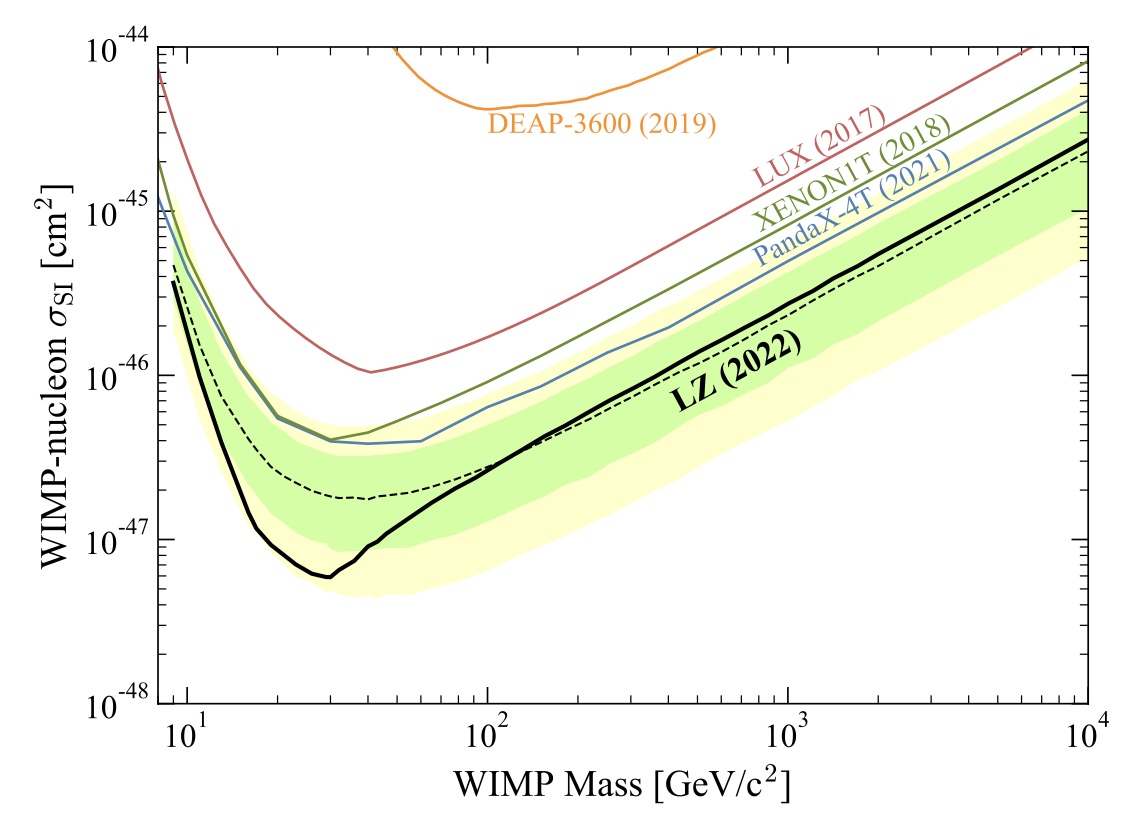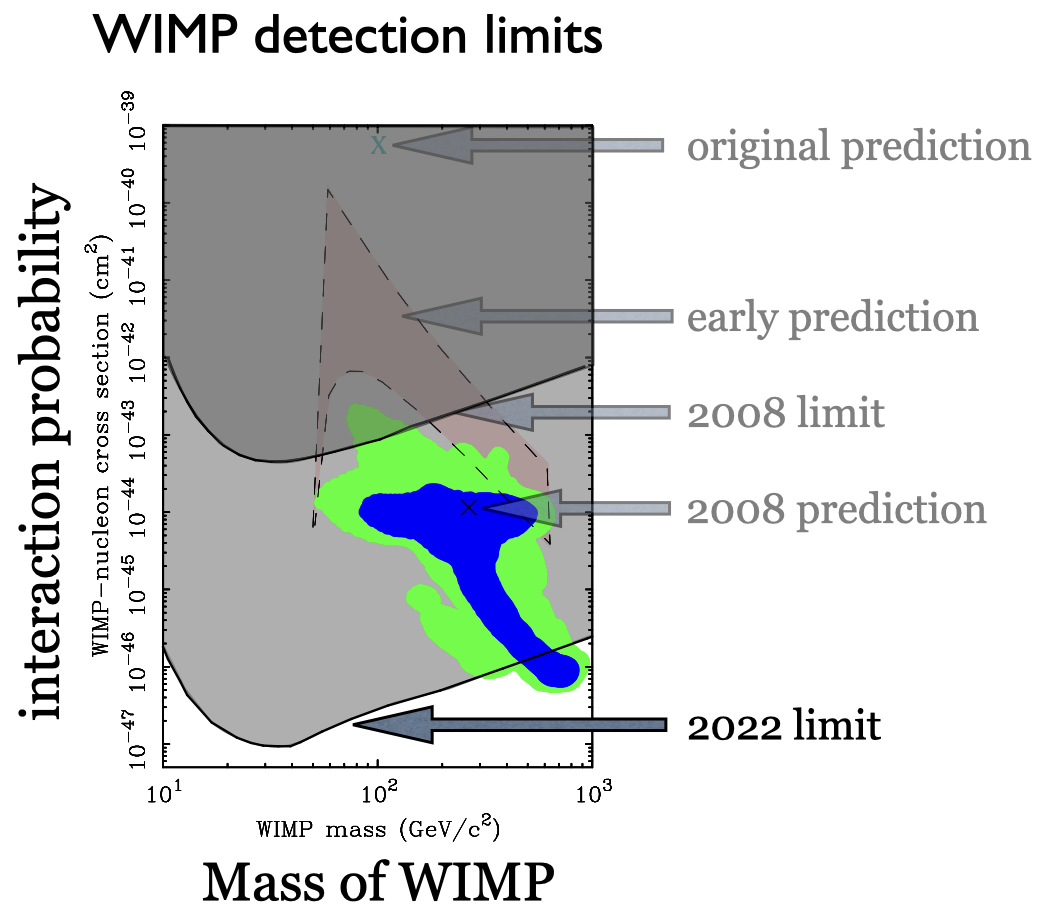Seeking WIMPs in all the wrong places
This article has been updated many times since it was first written in 2008,
at which time we were already many years down the path it describes.
The Need for Dark Matter
Extragalactic systems like
spiral galaxies and
clusters
of galaxies
exhibit mass discrepancies. The application of Newton's Law of Gravity
to the observed stars and gas fails to explain the rapid observed motions.
This leads to the inference that some form of invisible mass -
dark matter -
dominates the dynamics of the universe.
WIMPs
If asked what the dark matter is, most scientists working in the
field will respond honestly that we have no idea. There are many possible
candidates. Some, like MACHOs
(Massive
Compact Halo Objects, perhaps
brown dwarfs) have essentially been ruled out. However, in our heart of
hearts there is a huge odds-on favorite: the WIMP.
WIMP stands for
Weakly
Interacting Massive Particle. This is an entire
class of new fundamental particles that emerge from
supersymmetry.
Supersymmetry is a theoretical notion by which known elementary particles have
supersymmetric partner particles. This notion is not part of the
highly successful standard model of particle physics, but might exist
provided that the Higgs boson exists. In the so-called
Minimal
Supersymmetric Standard Model (MSSM), which was hypothesized to
explain the hierarchy
problem (i.e., why do the elementary particles
have the various masses that they do), the lightest stable supersymmetric
particle is the neutralino. This is the WIMP that presumably
makes up the dark matter.
Cosmology, meet particle physics
There is a confluence of history in the development of previously
distinct fields. The need for cosmological dark
matter became clear in the 1980s, the same time that MSSM was hypothesized
to solve the hierarchy problem in particle physics. Moreover, it was
quickly realized that the cosmological dark matter could not be normal
("baryonic") matter.
New fundamental particles therefore seemed a natural fit.
The cosmic craving for CDM
There are two cosmological reason why we need non-baryonic cold dark
matter (CDM):
- The measured density of gravitating mass appears to considerably
exceed that in normal matter as constrained by
Big Bang
Nucleosynthesis (BBN):
Ωm = 6 Ωb (so Ωnot baryons = 5 Ωbaryons).
- Gravity is too weak to grow the presently observed structures
(e.g., galaxies, clusters, filaments) from the smooth initial condition
observed in the
cosmic
microwave background (CMB) unless something speeds
up the process. Extra mass will do this, but it must not interact
with the photons of the CMB the way ordinary matter does.
By themselves, either of these arguments are strong. Together, they
were compelling enough to launch the CDM paradigm.
From the astronomical perspective, all that is required is that the
dark matter be non-baryonic and dynamically cold. Non-baryonic so that
it does not participate in Big Bang Nucleosynthesis or interact with photons
(a good way to remain invisible!), and dynamically cold (i.e., slow moving,
not relativistic) so that it can clump and form gravitationally bound
structures. Many things might satisfy these astronomical requirements.
For example, supermassive black holes fit the bill, though they would
somehow have to form in the first minute of creation in order not to
impact BBN.
The WIMP Miracle
From a particle physics perspective, the early universe was a high energy
place where energy and mass could switch from one form to the other freely
as enshrined in Einstein's E = mc2. Pairs of particles and
their antiparticles could come and go. However, as the universe expands,
it cools. As it cools, it loses the energy necessary to create
particle pairs. When this happens for a particular particle depends on
the mass of the particle - the more mass, the more energy is required,
and the earlier that particle-antiparticle pair "freeze out." After
freeze-out, the remaining particle-antiparticle pairs can mutually annihilate,
leaving only energy. To avoid this fate, there must either be some asymmetry
(apparently there was about one extra proton for every billion proton-antiproton
pairs - an asymmetry on which our existence depends even if we don't
yet understand
it) or the "cross section" - the probability for interacting - must be
so low that particles and their antiparticles go their separate ways without
meeting often enough to annihilate completely. This process leaves some
relic
density that depends on the properties of the particles.
If one asks what relic density is necessary to make up the cosmic dark
matter, the cross section that comes out is about that of the
weak nuclear force.
A particle that interacts through the weak force but not the
electromagnetic
force will have the about the right relic
density. Moreover, it won't interfere with BBN or the CMB. The WIMPs
hypothesized by supersymmetry fit the bill for cosmologists' CDM.
This coincidence of scales - the relic density and the weak force
interaction scale - is sometimes referred to as the "WIMP miracle"
and was part of the motivation to adopt the WIMP as the leading candidate
for cosmological dark matter.
WIMP detection experiments
WIMPs as CDM is a well posed scientific hypothesis subject to experimental
verification. From astronomical measurements, we know how much we need
in the solar neighborhood - about 0.3 GeV c-2 cm-3.
(That means there are a few hundred WIMPs passing through your body at any
given moment, depending on the exact mass of the particle.) From particle
physics, we know the weak interaction cross section, so can calculate the
probability of a WIMP interacting with normal matter. In this respect,
WIMPs are very much like neutrinos - they can pass right through solid
matter because they do not experience the electromagnetic interactions
that make ordinary matter solid. But once in a very rare while, they
may come close enough to an atomic nucleus to interact with it via the
weak force. This is the signature that can be sought experimentally.
There is a Nobel Prize waiting for whoever discovers the dark matter,
so there are now many experiments seeking to do so. Generically, these
use very pure samples of some element (like Germanium or Argon or Xenon) to act
as targets for the WIMPs making up the dark matter component of our Milky
Way Galaxy. The sensitivity required is phenomenal, and many mundane
background events (cosmic rays, natural radioactivity, clumsy colleagues
dropping beer cans) that might mimic WIMPs must be screened out. For
this reason, there is a strong desire to perform these experiments in
deep
mine shafts where the apparatus can be shielded from the cosmic
rays that bombard our planet and other practical nuisances.
The technology development involved in the hunt for WIMPs is amazing.
The experimentalists have accomplished phenomenal things in the hunt for
dark matter. That they have so far failed to detect it should give pause
to any thinking person aquainted with the history, techniques, and successes
of particle physics. This failure is both a surprise and disappointment to
those who understand modern cosmology. It
should not come as a surprise to anyone
familiar with the dynamical evidence for - and against - dark matter.
Searches for WIMPs are proceeding apace. The sensitivity of these
experiments is increasing at an accelerating rate. They already
provide important constraints - see the figure:
Searching for WIMPs

This plot was generated by DMTools.
|
This graph shows the status of searches for Weakly Interacting Massive
Particles (WIMPs).
The abscissa is the mass of the putative
WIMP particle. For reference, the proton has a mass of about one
in these units. The ordinate is a measure of the probability for WIMPs
to interact with normal matter. Not much!
The shaded regions represent theoretical expectations for WIMPs.
The light red region is the original (Ellis et al.) forecast.
The blue and green regions are more recent predictions (Trotta et al. 2008).
The lines are representative experimental limits. The region above each line
is excluded - if WIMPs had existed in that range of mass and interaction
probability, they would have been detected already. The top line
(from CDMS in 2004) excluded much of the original prediction. More recent
work (colored lines, circa 2008) now approach the currently expected
region.

|
April 2011 update:
XENON100 sees
nada. Note how the "expected" region
continues to retreat downward in cross section as experiments exclude the
previous sweet spots in this parameter. This is the express elevator to
hell (see below).
September 2011 update:
CREST-II
claims a detection. Unfortunately, their positive result violates limits
imposed by several other experiments, including XENON100. Somebody is
doing their false event rejection wrong.
July 2012 update:
XENON100
still seeing squat. Note that the "head" of the most probable (blue) region
in the figure above is now excluded.
It is interesting to compare the time sequence of their results:
first |
run 8 |
run 10.

November 2013 update:
LUX sees
nothing and excludes the various claims for detections
of light dark matter (see inset). This exclusion
of light dark matter appears to be highly significant as the very recent
prediction was for about dozen of
detections per month, which should have added up to an easy detection
rather than the observed absence of events in excess of the expected background.
Note also that the new exclusion boundary cuts deeply into the region predicted
for traditional heavy (~ 100 GeV) WIMPs by Buchmuelleur et al. as depicted by
Xenon100.
The Buchmuelleur et al. "prediction"
is already a downscaling from the bulk of probability predicted by
Trotta et al. (2008 - the blue region in the figure above). This perpetual
adjustment of the expectation for the WIMP cross-section is precisely the
dodgy moving of the goal posts that prompted me to first write this web page
years ago.
May 2014:
"Crunch time"
for dark matter comes and goes.
July 2016 update:
PandaX sees nada.
August 2016 update:
LUX continues to see nada.
The minimum of their exclusion line now reaches the bottom axis of the
2009 plot (above the line, with the now-excluded blue blob). The "predicted"
WIMP (gray area in the plot within this section)
appears to have migrated to
higher mass in addition to the downward
migration of the cross-section. I guess this is the sideways
turbolift to evil-Kirk universe hell.
 November 2019 update:
Xenon1T sees no sign of WIMPs. There is some hint of an excess of electron recoils. These are completely the wrong energy scale to be the signal that this experiment was designed to detect.
November 2019 update:
Xenon1T sees no sign of WIMPs. There is some hint of an excess of electron recoils. These are completely the wrong energy scale to be the signal that this experiment was designed to detect.
July 2022 update:
Xenon1T disavows any sign of excess electron recoils.
July 2022 update:
LZ extends the unbroken record of non-detections.
The experiments continue to improve (read the y-axis closely) and have repeatedly excluded the
regions where WIMP dark matter was reasonably expected to reside. Xenon addiction has become a
form of scientific alcoholism: just give us more and the results will be the same.
April 2011 update (continued):
Indeed, the experiments have perhaps been too successful. The original
region of cross section-mass parameter space in which WIMPs were expected
to reside was excluded years ago. Not easily dissuaded, theorists
waved their hands,
invoked the Majorana
see-saw mechanism,
and reduced
the interaction probability to safely non-detectable levels. This is the
vertical separation of the reddish and blue-green regions in the figure.
To quote a particle physicist,
"The most appealing possibility - a weak scale dark matter particle interacting with matter via Z-boson exchange - leads to the cross section of order 10-39 cm2 which was excluded back in the 80s by the first round of dark matter experiments. There exists another natural possibility for WIMP dark matter: a particle interacting via Higgs boson exchange. This would lead to the cross section in the 10-42 - 10-46 cm2 ballpark (depending on the Higgs mass and on the coupling of dark matter to the Higgs)."
Though set back and discouraged by this theoretical slight of hand
(the WIMP "miracle" is now more of a vague coincidence, like seeing an
old flame in Grand Central Station but failing to say anything
because (a) s/he is way over on another platform and (b) on reflection,
you're not really sure it was him or her after all), experimentalists
have been gaining ground on the newly predicted region. If all goes as
planned, most of the plausible parameter space will have been explored
in a few more years. (I write this in 2010. I have heard it asserted
that "we'll know what the dark matter is in 5 years"
every 5 years for the past two decades.)
June 2024 update based on 2022 LS results:
There is a natural tendency for the upper limits of exclusion plots to
migrate downwards along with the limits they portray. I thought it might be
instructive to update the plot above made with DMtools over a decade ago
to show the full range of progress:

|
The experimentalists have done a fabulous job in increasing the sensitivity
of their experiments. Had WIMPs existed as predicted, they would have been
detected by now. These experiments have succeeded brilliantly in failing.
Maybe WIMPs don't live here?
To update the quote from a particle physicsist, I've more recently hear it
said that the next logical expectation for the cross-section is around
10-48 cm2 due to "two-loop corrections." I have only
a vague idea of what that means, but in my practical experience it translates
to "an effect so exotic that it likely has no bearing on reality, except maybe
in the sixth place of decimals."
This is the very personification of the express elevator to hell (see below).
The problem with pushing detection limits to still lower cross-sections is
that the universe is indeed full of weakly interacting particles with at least
a little bit of mass: neutrinos. These are not as massive as WIMPs, and should
not be conflated with them: neutrinos are Standard Model particles that are
known to exist and to have a very small mass (< 1 eV) while WIMPs are
expected to be hundregs of GeV and require entirely new physics beyond the
Standard Model. I shouldn't need to say this, but I've noticed some of the
more rabid advocates of dark matter intentionally conflate these two in
order to claim that we know weakly interacting dark matter exists. That is,
in techincal parlance, Some Bullshit. No, actually it is worse: a sort of
willful scientific disinformation.
At any rate, the coming generation of WIMP detectors should be sensitive to
the neutrino background. That is astrophysically interesting, as it can
probe nuclear reactions in the sun and the relics of all the supernovae that
have ever exploded. It has bugger all to do with dark matter, but since that's
what they're looking for, and they're already convinced it exists, and a Nobel
prize awaits whoever detects it first, I expect that the first neutrino
detections will be misinterpreted as WIMP detections. There will be much
arguing between groups, claims and counterclaims, and after a few years it
will be recognized that these coming detections are neutrinos not WIMPs,
but probably first there will be many claims that mislead the public into
thinking dark matter has been detected.
Man, being a scientific
Cassandra is getting old.
Return to material written in 2008, or as otherwise noted:
The express elevator to hell
There is a slight problem with the current predictions for WIMPs. While
there is a clear focus point where WIMPs most probably reside (the blue
blob in the figure), there is also a long tail to low interaction
cross section. If we fail to detect WIMPs when experimental sensitivity
encompasses the blob, the presumption will be that we're just unlucky and
WIMPs happen to live in the low-probability tail
that is not yet excluded. (Low probability regions tend to seem more
reasonable as higher probability regions are rejected and we forget
about them.) This is the express elevator to hell. No matter how
much time, money, and effort we invest in further experimentation,
the answer will always be right around the corner.
This process can go on forever.
Is dark matter a scientific (falsifiable) hypothesis?
The existence of dark matter is an inference, not an experimental fact.
Individual candidates for the dark matter can be tested and falsified.
For example, it was once reasonable to imagine that innumerable brown
dwarfs could be the dark matter. That is no longer true - were there that
many brown dwarfs out there, we would have seen them directly by now. The brown
dwarf hypothesis has been falsified. WIMPs are falsifiable dark matter
candidates - provided we don't continually revise their interaction
probability. If we keep doing this, the hypothesis ceases to have predictive
power and is no longer subject to falsification.
The concept of dark matter is not falsifiable.
If we exclude one candidate, we are free to make up another one. After
WIMPs, the next obvious candidate is
axions.
Should those be falsified,
we invent something else. (Particle physicists love to do this.
The literature is littered with half-baked dark matter candidates invented
for dubious reasons, often to explain phenomena with obvious astrophysical
causes. The ludicrous uproar over the
ATIC
and
PAMELA
cosmic ray experiments is a good example.)
September 2011 update:
Fermi
confirms the PAMELA positron excess. Too well for it to be dark matter:
there is no upper threshold energy corresponding to the WIMP mass.
Apparently these cosmic rays are astrophysical in origin, which comes as
no surprise to high energy astrophysicists.
April 2013 update:
AMS
makes claims to detect dark matter that are so laughably absurd they do not
warrant commentary. Note added in 2021: Apparently
everyone else thought so too, as these claims now seem to have been
forgotton entirely.
September 2016 update:
There is no update. People seem to have given up on claiming that there is
any sign of dark matter in cosmic rays. There have been claims of dark matter
causing signatures in gamma ray data and seperately in X-ray data. These
never looked credible and went away on a time scale shorter than how often
I update these pages.
November 2021 update: As anticipated, some people are tiring of WIMPs and are now
talking up axions
as a dark matter candidate.
They seem to be treading the same path as with cosmic rays, getting really excited about
astrophysics they don't understand as evidence for axions. This will have the same trajectory:
early enthusiasm, sobering work, and the ultimate grudging realization that astrophysical problems have
astrophysical solutions that have bugger all to do with dark matter.
The express elevator doesn't just go down to hell.
It keeps going there over and over again.
Some perspective on scale
The inference of dark matter is based on absolute faith in
the application of Newtonian dynamics to scales very different than where
the they have been experimentally tested. This faith seems well placed,
but the mass discrepancy occurs on scales inaccessible to laboratory experiment.
The need for dark matter appears in galaxies that are 100,000,000 times
larger than the solar system and on acceleration scales 100,000,000,000
times smaller than we experience on the surface of the earth.
The inference of dark matter could just as well be interpreted as an
indication of the failure of purely Newtonian dynamics.
Why does MOND work so well?
People have, of course, considered modifications to gravitational theory
as an alternative to dark matter. It is hard to do this without breaking
something else fundamental. So hard that the widespread presumption is
that it is impossible. Indeed, the vast majority of modified gravity
hypotheses quickly fail when confronted with astronomical data, never mind
theoretical objections. For example, it is possible to exclude any
modification that is simply based on changing the force law at a particular
length scale.
One hypothesis to modify Newtonain dynamics,
MOND,
has endured since 1983, despite frequent claims to falsify it. (So far most
of these claims have proven to be premature or outright wrong though there
are a few that should be taken seriously.)
More disturbing to me than the supposed failures of MOND is that it
works so well. This should not happen if dark matter is the right answer.
MOND has persistently had
more predictive success in galaxies than have dark matter models.
The phenomenological success of MOND has some curious consequences for
dark matter.
Whatever the dark matter is, it has to look, smell, and act like MOND.
This is no trivial feat. MOND is a simple formula connecting the
observed distribution of stars and gas unique to each galaxy to the
dynamics that are uniquely observed for each galaxy. There is no
reference to the dark matter that is suppose to dominate the show.
The baryonic tail wags the dark matter dog.
 Though well established observationally, the MONDian phenomenology
is widely ignored by modelers seeking to explain the pertinent data.
Ignoring facts is not healthy in science.
Though well established observationally, the MONDian phenomenology
is widely ignored by modelers seeking to explain the pertinent data.
Ignoring facts is not healthy in science.
The many failings of CDM on galaxy scales are routinely attributed to
"feedback" from star formation mucking things up.
On the one hand, this is legitimate: the CDM theory can accurately
predict what the dark matter does, but not what the luminous matter does.
Since we can only observe the latter, it is reasonable to imagine that there
is more to the story than just what the CDM should do when left to itself.
On the other hand, what
galaxies are observed to do could hardly be less reasonable: follow the
predictions of the antithesis of dark matter. In spite of enormous effort,
feedback remains nothing more than a fig leaf to hide our ignorance of
how things came to be so.
I have made considerable efforts to understand the observed MONDian
phenomenology in terms of dark matter. I have failed. A few others
have claimed to succeed. Either they are more clever than me, or more
self-deluded and less intellectually honest. For some reason, I have
never seen their results reproduced in the literature: the expectation
for feedback keeps changing.
The problem is fundamental. We are trying to take a simple observed
phenomenon, and reproduce it with a complicated feedback scheme with
many free parameters. One can, of course, fit anything with such a
procedure. That was the problem with epicycles. The modern situation
may well be analogous: we add epicycles of feedback to make our CDM
model look like MOND. But does that mean that dark matter is just the
modern version of Æther? A ubiquitous, invisible substance that simply
must exist...
Oh, ye seekers after dark matter, how many vain chimeras have you pursued?
Go and take your place with the alchemists.
paraphrased from Leonardo da Vinci
This article in
Spanish



 November 2019 update:
Xenon1T sees no sign of WIMPs. There is some hint of an excess of electron recoils. These are completely the wrong energy scale to be the signal that this experiment was designed to detect.
November 2019 update:
Xenon1T sees no sign of WIMPs. There is some hint of an excess of electron recoils. These are completely the wrong energy scale to be the signal that this experiment was designed to detect.

 "We're on an express elevator to hell - going down!"
"We're on an express elevator to hell - going down!"
 Though well established observationally, the MONDian phenomenology
is widely ignored by modelers seeking to explain the pertinent data.
Ignoring facts is not healthy in science.
Though well established observationally, the MONDian phenomenology
is widely ignored by modelers seeking to explain the pertinent data.
Ignoring facts is not healthy in science.